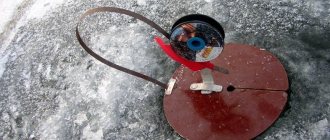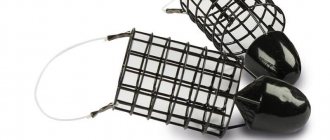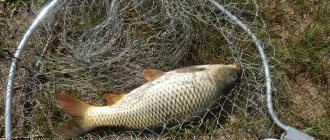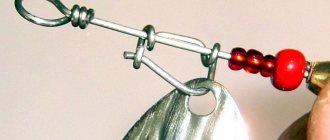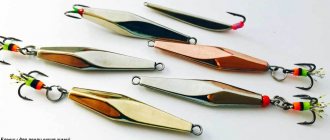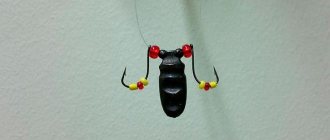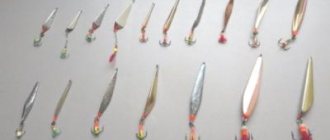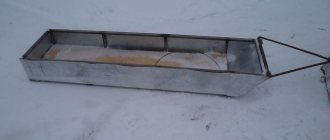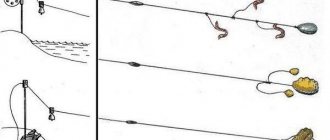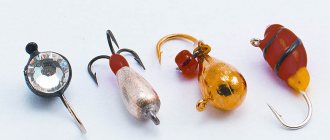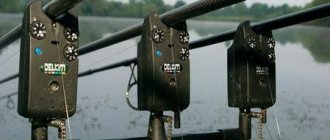Main types
Usually carp are caught with either float or feeder rods.
For productive fishing, the first ones are equipped as follows:
- A reel containing 100 meters of fishing line.
- A monofilament line with a diameter of 2.5 mm, which is useful for a leash.
- Sliding installation.
- Lead twists for sinkers.
- Hooks numbered 6, 8 or 10.
The feeder fishing rod requires the following equipment:
- A 2.5-meter rod must have a sensitive tip and a plug connection;
- A reel containing a fishing line with a diameter of 0.25 mm.
- Leash length from 40 to 80 centimeters.
Float rod
All summer and early autumn, carp are caught using a float rod. The inhabitant of a reservoir with a silted bottom bites on a float, since it will be more difficult to catch it on a donk. This fascinating process is not at all as easy as many people think.
To catch an impressive specimen on a float rod, you should equip it with:
- a match or plug rod 5 meters long, durable, with an elastic top and guide rings;
- a small inertia-free reel equipped with a friction brake;
- high-quality fishing line with a diameter of up to 0.35 millimeters;
- leash made of fluorocarbon fishing line;
- an ordinary float with a carrying capacity of 3-5 grams and a long antenna;
- an inconspicuous sinker;
- forged hooks No. 2 to 8 with a short shank and a wide hook width.
Installation is aimed at distributing the load over the entire tackle. The mass of the weights is such that the float is immersed in the water, protruding ¼ of the way. When carp hunting with a float rod, patience and perseverance are required. A fish can bite suddenly or unnoticed. Here it is important to hook in time, without giving the line slack. It is worth extinguishing the jerks of the trophy, not allowing it to leave, tiring it. Useful when fishing with landing nets.
Carp rigs with feeder
In-line
One of the simplest, most effective and popular options for installing equipment. Its essence lies in the fact that the anti-spinner passes directly through the center of the sinker. Inline is often used when fishing on a pond or small lake, because there is no need for long casting.
Another advantage, in addition to the simplicity of knitting, is the fact that when using this type of installation, the carp will encounter the mass of the entire pear-shaped sinker. Therefore, hooking will be very effective.
This is achieved due to the close location of the leash in relation to the center of gravity of the sinker. If you change its shape from pear-shaped to flat or even use a “bump”, then the inline will be suitable for fishing in the current.
Thus, when using different sinker configurations, this type of installation becomes unique. The main disadvantages of inline are unsatisfactory aerodynamics during casting and limited range.
Assembly method:
- The swivel is tied to the fishing line.
- After this, a rubber stopper is firmly tied.
- The line is pulled into the feeder.
- The fishing line is stretched 35 centimeters further and a loop is made from it.
- For a leash you need monofilament 10-12 centimeters long.
- Next, the hook, which has a hair rig, is attached.
Carp equipment In-line
Killer of crucian carp and crucian carp
This equipment is a modernization of standard equipment equipped with a feeder weight. Usually these are 3 feeder springs that are connected by a fishing line. Each spring is equipped with a hook on a short leader on which the bait is placed.
There is bait on the spring. When submerged, it will begin to erode and attract fish. When eating bait, the fish will swallow the hook and, when trying to spit it out, will hook itself. All that remains is to get the prey by making a control hook.
You can construct a killer with your own hands. Advantages: high chance of catching prey and ensuring self-hooking. Disadvantages: imperfect structure and poor sensitivity.
How to assemble:
- A fishing line is passed through the springs.
- Using rubber stoppers, springs are fixed every 10 centimeters.
- The sinker is tied at one end of the fishing line.
- On the other there is a swivel equipped with a latch.
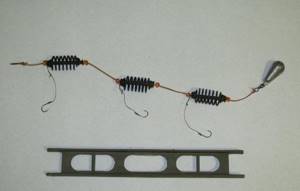
Equipment “Killer of crucian carp and crucian carp”
Blind equipment
The main difference from previous installation options is the length of the leash. It is very short, which allows you to increase casting distance and increase sensitivity.
Such a leash guarantees a quick hook, so the carp will not be able to react in time. Such tackle does not slip. Blind equipment is used when fishing at shallow depths.
Assembly order:
- The hook leader is tied to the swivel.
- The fishing line is passed through the silicone pipe and clip.
- Its beginning is attached to the swivel.
- The end is pulled to the main part of the line through a swivel.
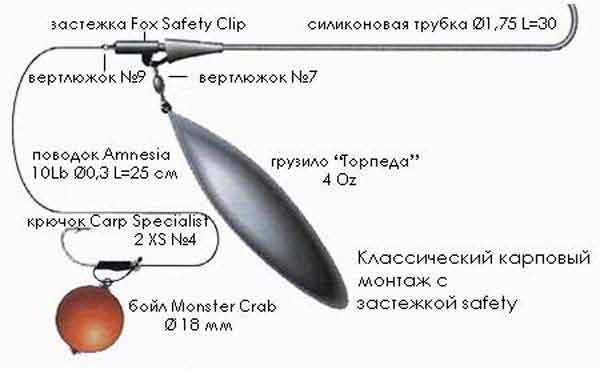
Blind equipment
Equipment with anti-twist
This kind of installation for a feeder is perfect for fishing in strong currents, as the bite is transmitted well and the reel holds well. The main argument of opponents of equipment with an anti-twist is the presence of a foreign object that can scare the fish.
The assembly proceeds as follows:
- The monofilament thread is inserted into an anti-twist machine equipped with stoppers at the ends.
- The lower swivel is fixed, after which there is a leash with a hook.
- Mounting the feeder on a carbine.
- As a result, the long end should be in the direction of the leash.
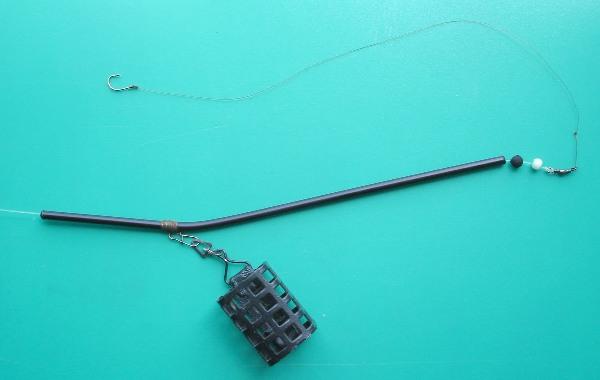
Equipment with anti-twist
Helicopter
A feeder installation of this type will be optimal for fishing from long distances and in the current. Even in cases where a lot of effort and a lot of patience are spent during creation, the helicopter will pay off.
To create a montage, prepare:
- leadcore with a clutch and an igloo for it;
- two rubber beads;
- cargo;
- swivels;
- thermal shrink tube (length - from 40 to 60 millimeters);
- PVA bag.
Installation process:
- The sinker is installed on the shock leader.
- A coupling is put on the swivel and leader using a needle.
- The weight is attached to the thermal tube.
- The leash is attached to the swivel ring, the shock leader is attached to the monofilament.
- We must not forget about ensuring the free movement of the beads along the thread to the knot.
- The sinker and bait are poured into a PVA bag.
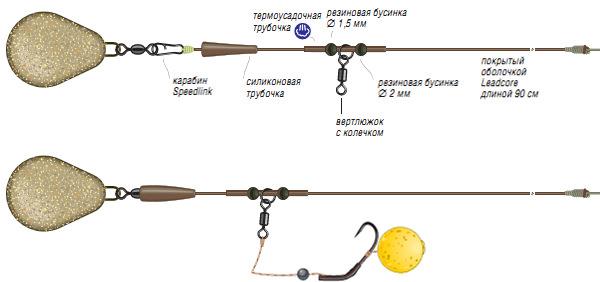
Equipment “Helicopter”
Safety clip
This installation technique is particularly popular. If it catches tightly, the weight will move away. To create a secure clip, you need a clip, a weight, a cone-like coupling, a swivel and a rigging house.
Assembly instructions:
- A monofilament thread is inserted into a 300 mm tube.
- Its end is threaded through the coupling and compressed into a tube.
- The swivel and coupling are mounted on a clip.
- The swivel is attached to the other end of the monofilament.
- Then it is threaded through the clip and attached to the leash.
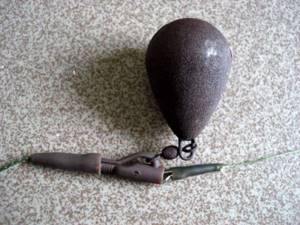
“Safety clip” accessory
Harvester
There are almost no differences between this equipment option and a standard carp spring, but there are additional advantages:
- Firstly, the combine is easy to make.
- Secondly, casting can be carried out over long distances.
- Thirdly, the system is simply convenient.
Creation instructions:
- The springs are made cone-shaped. At the narrowest point their size should be no more than 2 mm, and at the widest point - 4 mm.
- The total length of the feeder is up to five centimeters.
- The eyelet is made on its upper part, the swivel is attached to it.
- The main line is tied to the swivel.
- 3-5 leashes, up to 8 centimeters long, are attached to the carbine.
- It then fits onto the swivel at the top.
- One of the leads is pulled out through the spring.
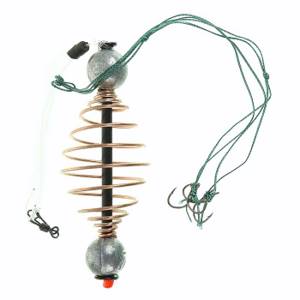
Harvester equipment
Flat method
A very famous installation option. The appearance of the feeder resembles a balalaika, one part of which is flat. The equipment is perfect for fishing in those reservoirs where the bottom is covered with marshy silt or deep algae, because it will not fall into them.
Flat feeders provide good casting accuracy and range. You can also make them yourself.
For this you will need:
- stainless steel wire;
- metal pin;
- plastic tube;
- the mold in which the lead base will be cast.
How to assemble:
- A bent wire with a pin is placed in a mold into which molten lead is poured.
- After cooling, the product is pulled out, the pin is removed, and a plastic tube is glued in its place.
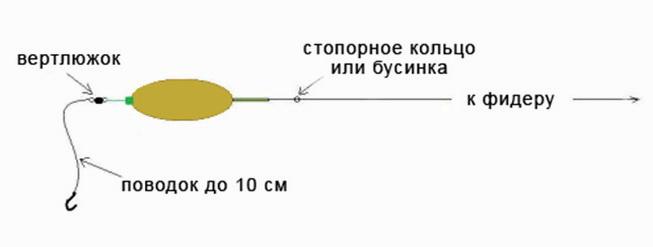
Carp rig “Flat method”
Symmetrical loop
If there was an official list of popular rigs for carp fishing, the symmetrical loop would consistently be in the top three. This is a popular feeder rig with the effect of self-hooking fish. As a standard, it is used in reservoirs where the current is very weak.
For self-assembly you will need:
- monofilament;
- a pair of swivels with clasp;
- sinker;
- feeder;
- fluorocarbon line for the leader;
- hook.
The assembly process has the following sequence:
- The main line is folded in half, and its ends are turned in any direction.
- This operation (twisting) is repeated ten times, after which a knot is made.
- The swivel is threaded through the fishing line, and a free space is left twenty centimeters from it.
- The knot is twisted, then the line is rolled up again. A second swivel is attached to its other end.
- At one end of the fishing line, a loop is folded and a leash 50 centimeters long is tied to it.
- The hook is attached at its tip.

Equipment “Symmetrical loop”
Asymmetrical loop
The main feature is high sensitivity and efficiency. It is usually used for fishing in large currents in a body of water. Materials to make: monofilament line, a feeder, a pair of swivels, a sinker, a number 8 hook and fluorocarbon line to create a leader.
To assemble such an installation you need:
- The beginning is the same as that of a symmetrical loop. The main part of the fishing line is folded in half, and the ends are wrapped in either direction.
- At the first end one of the swivels, a feeder and a sinker are attached.
- On the other there is a second swivel. This is where the knot is tied.
- A leash is attached and a hook is tied at its end.
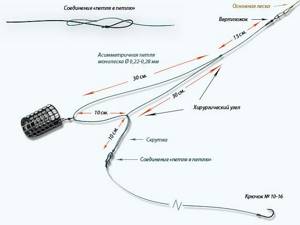
Equipment “Asymmetrical loop”
Paternoster
Almost the easiest equipment to implement, which at the same time remains very effective, is the paternoster.
For installation you will need:
- braided line with a diameter of 0.13 mm;
- monofilament with a diameter of 0.2 mm;
- “cage” type feeder, which is equipped with a clasp.
The choice of hooks will depend on the size of the fish:
- Number 12 or 15 are suitable for small fish;
- 7 and 8 - for a larger catch.
Build process:
- The line is wound onto a reel, after which it is pulled into the rings of the rod.
- Then the line is bent in half a meter from the end of the fishing rod. A knot is tied 20 centimeters from the edge.
- The sinker along with the feeder is attached to the resulting loop.
- A twenty-centimeter long segment is tied to the remaining segment. It is designed for a leash.
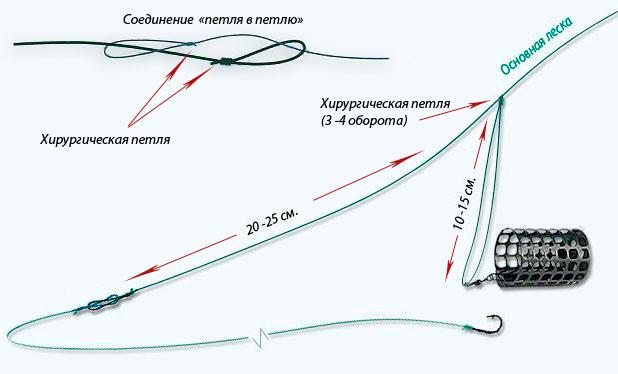
Equipment “Paternoster”
Hair hook rig
The main feature is that there is no need to put bait on the hook. It will go down the carp's throat when it swallows the boilie. You'll have to use auto hooking. Hair equipment requires a hook for installation, which must have maximum strength, and hair (soft and small in diameter).
The assembly proceeds as follows:
- The bait is attached at a distance of 2 centimeters from the hook.
- The hair is wrapped several times to be able to lengthen it later.
- The hair rig is ready!
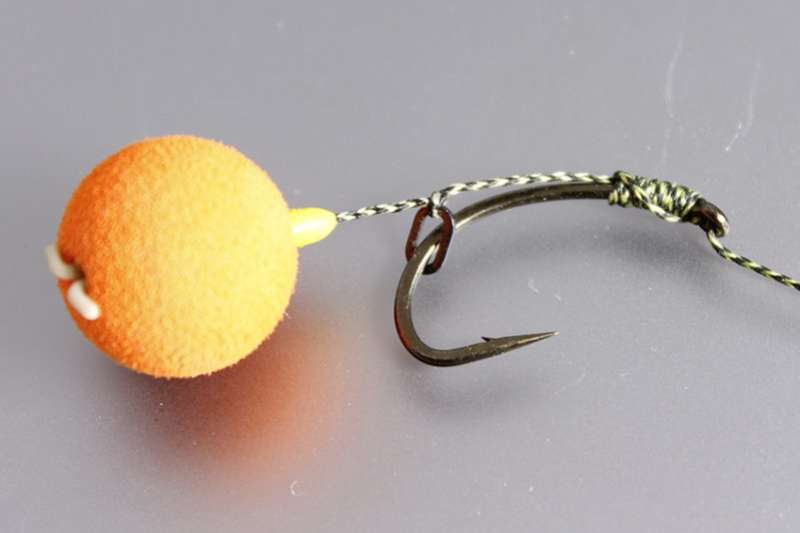
Hair hook rig
Hair knotless installation on carp: step-by-step manufacturing process
With this type of installation, the carp is always caught by the lower lip. This is much less traumatic for the carp itself and reduces the likelihood of empty hookings.
Manufacturing:
- We take material for the leash. We cut off the length we need (25-30 cm) and thread it through the ring of the hook. You need to thread it from the tip side.
- Using a mounting needle, we put a piece of silicone tube onto the shank of the hook. We put it through the sting. The diameter of the tube must correspond to the thickness of the forend and fit tightly to it. We place it on the fore-end opposite the hook point. We thread a leash inside the tube.
- Make a loop at the tip of the leash threaded through the tube. Cut off the unnecessary part of the leader material. As mentioned above, the loop should be no more than 2.5 cm from the sting.
- We take a boilie, thread a loop through it using a mounting needle, and use a stopper to secure the boilie to the hair.
- We wrap the free part of the leash along the fore-end 6-7 times and thread it into the ring so that it comes out from the side of the hook tip. We measure the length of the leash we need and make a loop there. The hair knotless leash is ready.
Required components
Hooks
First decide on your hook. For catching carp, three types are often used: with a sting curved inward or bent back, as well as hooks with a long and concave shank.
It is preferable to use those that have a tip curved inward. When used, the chances of effective hooking and reliable swallowing by the fish increase.
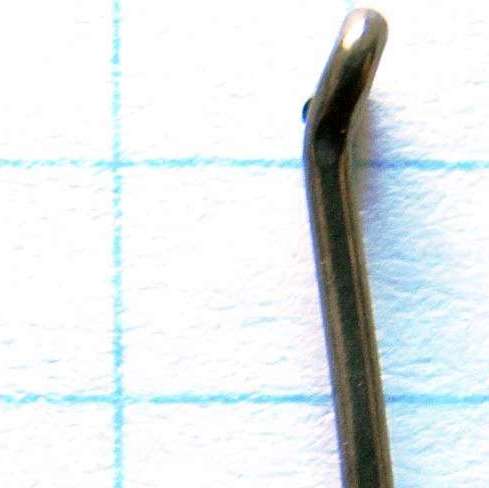
Hook with an eye bent back

Hook with inward eye
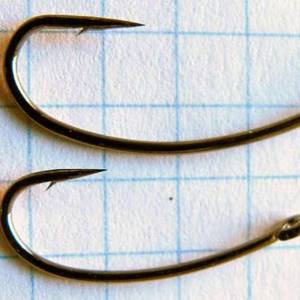
Hook with a long curved shank inward (banana)

Straight eye hook
Leashes
In carp fishing, floating, invisible, sinking and neutral leashes are used.
Their choice will depend on taking into account the characteristics of all types:
- A long leash scares the carp less, but the fish will have more time to free themselves from the hook.
- With a short leash, the bite can be noticed literally immediately, but it will be more frightening.
Therefore, when fishing for carp, it is preferable to use them because it has a more elongated body.
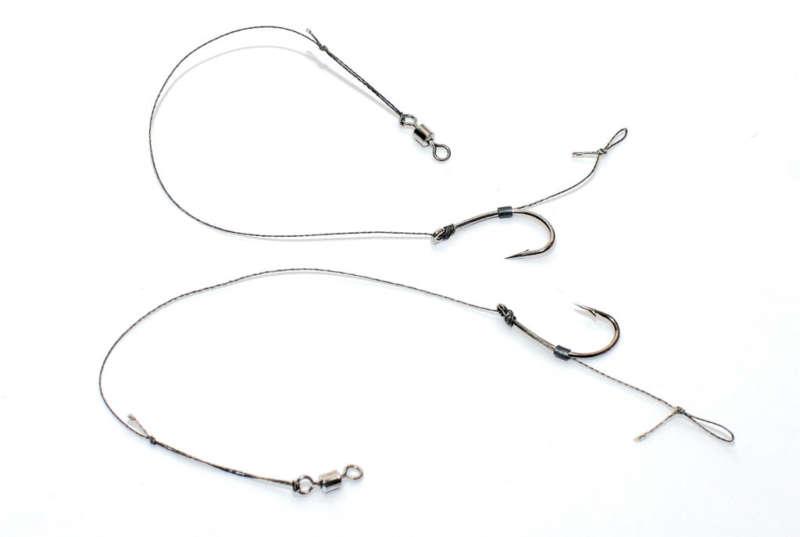
Combined leash for carp fishing
Sinkers
They are one of the most important components when fishing for carp.
In order for fishing to be successful, the following characteristics of the weight are needed:
- It should firmly hold the equipment in any type of bottom in any area.
- The sinker must provide excellent line pressure for early notification of a bite.
- Conditions must be provided for the location of the bait at the required distance.
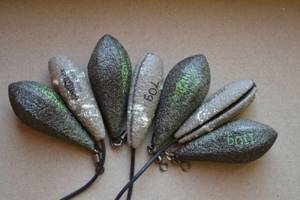
Sinkers for carp fishing
Anti-twist
This is required when using the safety clip. When choosing, pay attention to the smell of the anti-twist.
It sounds strange, but carp are susceptible to them, so a good fisherman needs to choose quality products that do not have a specific smell. The anti-twist tubes should not shine, so as not to scare away the fish.
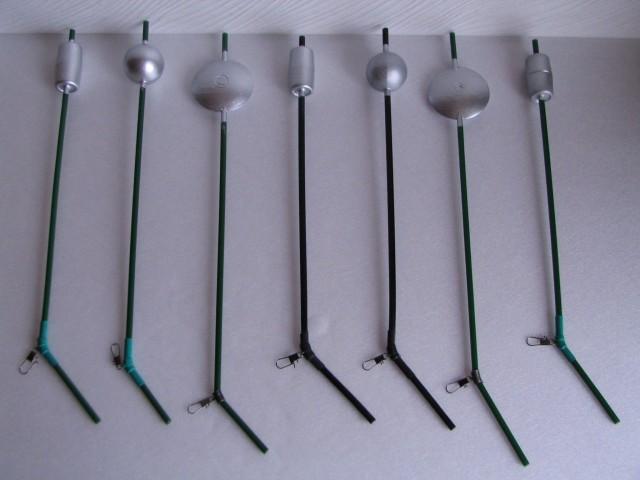
Anti-twisters with three types of floats - spindle, ball, tablet
Swivels
The main functions of these devices are:
- Attaching the stopper in the place where the sinker connects.
- Prevent twisting of equipment.
The most versatile and popular are number 10 swivels. They fit any clip. When choosing a swivel, remember that the rule “bigger is better” applies here.
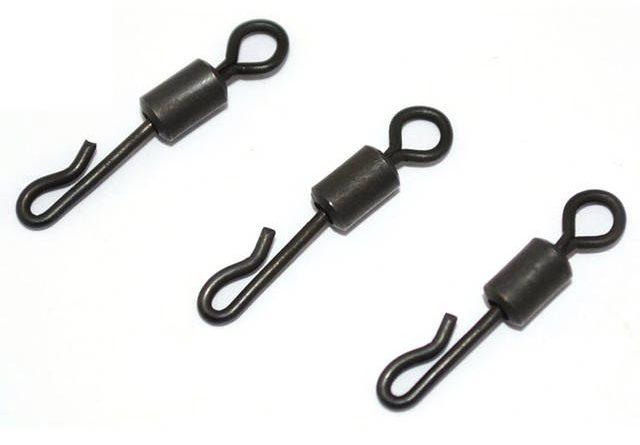
Swivels
Requirements for bait and attachments when using feeders
The main requirements that are usually attributed to baits and baits:
- The finished bait mixture should be as viscous and viscous as possible. This is necessary so that after immersion in water it does not begin to dissolve into small particles, but stays tightly in the feeder.
- When dissolved in water, complementary food should form a cloud that attracts fish. This usually comes with experience, and fishermen already know what consistency the bait needs to be cooked.
- Bait and complementary foods should be used depending on what kind of fish you are going to catch. For example, for larger species of fish (bream, pike, carp and others), live components should be mixed in the complementary food, and for grass carp and other herbivorous fish - crushed algae and other herbal additives.
The best baits for bottom fishing are:
- Worms.
- Boiled corn.
- Pearl barley.
Bait should be selected depending on the following factors:
- Taste habits and preference for fish.
- How will complementary foods behave in water and how long will it retain the required smell.
It is best to use the following as bottom baits:
- Canned corn (canned).
- Worms.
- Pearl barley.
- Wheat.
- Boilies.
- Maggots.
Selection of equipment depending on fishing conditions
Smooth bottom
Use a paternoster if there is crucian carp in the by-catch and a flat method when targeting carp.
This is where a simple and effective hair rig comes in handy.
driftwood
It’s better not to fish in snags at all. But if there is no choice, then use Inline and oval weights.
IL
Only paternoster and flat method. The first one, having drowned in the silt, will not take the bait with him, and the second one simply will not drown due to the shape of the feeder.
Adviсe
Some recommendations:
- We recommend that you wet the knot before tightening it. This will strengthen it and prevent the line from breaking.
- If there is no bite, there is no need to change the equipment completely, only a partial change is enough.
- In order to achieve an even and smooth position of the bait on the bottom, it is best to attach a spring or sinker to the tip of the fishing line.
- It is best to use different types of bait in springs. This will significantly increase the chance of attracting carp.
